Co-op of the Day: 111 Hicks Street, #8N
For a decently laid-out, two-bed, two-bath apartment in a prewar elevator building, Apartment 8N at 111 Hicks Street in Brooklyn Heights looked priced to sell to us at $650,000 until we noticed the cumbersome monthyl maintenance of $1,665. After all, this is equivalent to a $750,000 apartment with a maintenance of $1,100 or so. Think…


For a decently laid-out, two-bed, two-bath apartment in a prewar elevator building, Apartment 8N at 111 Hicks Street in Brooklyn Heights looked priced to sell to us at $650,000 until we noticed the cumbersome monthyl maintenance of $1,665. After all, this is equivalent to a $750,000 apartment with a maintenance of $1,100 or so. Think it’ll sell?
111 Hicks Street, #8N [Douglas Elliman] GMAP P*Shark





Sam,
“your analyis is a little simplistic”
Yes, it was intentional since I didn’t feel like going into details. I just pointed out one reason why some underlying mortgages are much bigger than the conversion cost.
“I am a big booster of co-ops”
Me too. I own one now and plan to buy one more next year.
Someday we’ll have a Brooklyn Heights co-op of the day without an absurdly high maintenance.
thanks again guys.
Wow – this could lead to a pretty f-ed up situation. I understood the basic differences between coops and condos but this adds a whole new dimension to it.
To draw an analogy to my day job, buying a cheap coop without considering the corporations finances seems akin to buying a stock on a low P/E without considering the balance sheet. ie People didn’t particularly care on the way up but once you enter a shaky market they care an awful lot.
Someday we’ll have a Brooklyn Heights co-op of the day thread without 90% of the comments relating to the absurdly high maintenance.
Not sure when that day will ever be, but you have to figure the law of averages will win out eventually.
It’s very easy for cc’s to get out of hand. For our little building, taxes and fuel costs over the past two years pushed it up 25%…and we refi’d during that time, too. Another big cost for full service buildings is staffing. Doormen, porters, handymen etc. are all unionized, and you can’t lay them off or cut their pay–their pay/benefits go up, too. This little apt. has a great layout, but it won’t sell at this price.
Gravis,
your analyis is a little simplistic.
when an owner wishes to convert a building to a co-op, the process generally has high costs. For one thing, the Attorney General will wish to see all DOB violations addressed, then rent-regulated tenants need to be given buy-outs, then the building’s common spaces such as the entry, lobby, hallways etc generally need to be updated as NYC rent-regulated buildings often look like something out of the Soviet Gulag. All of these expenses, plus the cost of acquiring the property generally represent the bulk of the underlying mortgage. There is really little difference between paying your own mortgage interest and the corporation’s mortgage interest. Market prices reflect the large or small debt service to the underlying mortgage. Co-ops are not evil tools of Satan, they are sophisticated mechanisms insuring high-quality residential units to sophisticated city dwellers. I am a big booster of co-ops. I think they are a product of NY and they work exceptionally well in NY.
The Chicken,
I might be able to answer this as well. From what I heard, the following is an example of condo/co-op conversion that previously had no mortgages as a rental building:
Let’s say there is a landlord, who wants to sell %70 of his/her building (100 units; cost of building before the conversion is $10M). He/she has 2 options:
– Convert to condos. Sell %70 apartments (70 units) at $100K each. Money in his/her pocket = $7M + rental of remaining 30 units.
– Convert to a co-op. Get an underlying mortgage of $7.5M and run with it. Sell %70 apartments (70 units) at $50K. Money in his/her pocket = $11M + rental of remaining 30 units.
Obviously, most landlords went with the second option. While the landlord (a.k.a. sponsor) might have pocketed up to %100 of the underlying mortgage funds, as a shareholder of the co-op, he/she only has to worry about %30 of it.
This is a nice old Art Deco building. The roof terrace is simply unbelievable. The thing for a buyer to do if they are looking at various co-op buildings is to compare the “debt per share” ratio. In other words how much debt, both mortgage and underlying mortgage, will you be servicing per share. A similar apartment with lower maintenance but higher price may work out to be the same.
Obviously if the maintenance on this apartment were $900 the sale price (and hence your mortgage) would be a lot more. For those with good incomes, but not much savings, something like this would make sense in tems of making the down payment. The old St George has a lot of amenities including a pool and health club membership that comes free with ownership. 8th floor windows must have noce views even if they face Brooklyn and it is a full-service building. definitely not for the frugal but then buying in Brooklyn Heights is not a bargain.
chicken — The cooperative corporation owns the building; shareholders buy shares that give them right ot proprietary lease for specific unit. A sponsor sells the shares — not the building. This building’s sponsor may have left it with a bad mortgage, or it may have needed a big capital expenditure financed through a mortgage. The maintainance here is high as it is a big building (usually that helps spread the pain).
The mortgage is the bank’s assesment of the vlaue of the building, and the banks will factor % resident owners (more is better), reserve funds, arrearages — everything. Coop mortages are generally 7-10 years in length — no more.